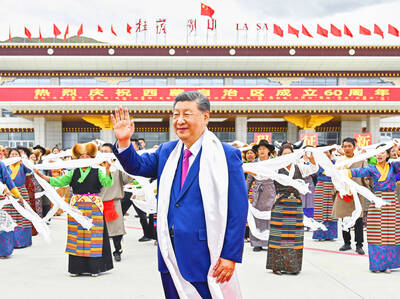Traditional owners said they were “devastated and traumatized” by the alleged damage to a 1,500-year-old heritage-listed stone arrangement that curved up the hill in the shape of an eel, and was a significant ceremonial and meeting site prior to European colonization of Australia.
The Kuyang stone arrangement stretched across 176m of private farmland at Lake Bolac in southwestern Victoria, about 230km west of Melbourne.
It is visible from the Glenelg Highway, and the tail end of the structure was reportedly damaged when the highway was created.
On Sunday, a non-Indigenous local living in the Lake Bolac area reported that a section of the stone arrangement appeared to have been damaged by a grader.
Inspectors from the regulator, Aboriginal Victoria, yesterday traveled to Lake Bolac to assess the reported damage.
The registered Aboriginal party, the Eastern Maar Aboriginal Corp, said up to 60m of the stone arrangement appears to have been destroyed.
Company chief executive officer Marcus Clarke, a Gunditjmara-Kirrae Whurrong man, said it was “pretty devastating” to hear that the site had been damaged.
“We can’t underestimate the importance of the site or the devastation the destruction has caused,” he said. “The Lake Bolac site has been an important gathering site prior to European colonization and is steeped in cultural and historical importance.”
The stone arrangement sits on private farmland that has been owned by the same family for more than 120 years.
Clarke said members of Eastern Maar Aboriginal Corp viewed the site from the roadside after the damage was reported.
He said they do not have the authority to go onto private land and would wait for the Aboriginal Victoria heritage assessment team to provide its initial report.
“[We are] devastated, it’s pretty traumatic,” he said. “Cultural heritage in the landscape underpins pretty much everything that we do, and that’s our role — to protect cultural heritage. [Damage to] something as significant as that site, it’s pretty traumatic.”
He said the site was “very well known” by both Aboriginal and non-Aboriginal people in the area, due to the annual eel festival at Lake Bolac and because the site is visible from the road.
It is just 100km from the world heritage-listed Budj Bim eel traps.
Clarke said the destruction by Rio Tinto of the Juukan Gorge Aboriginal heritage site in Western Australia had raised the profile of protecting Aboriginal heritage in the national psyche, and Aboriginal Victoria had also worked with landowners to ensure they were aware of their obligations to protect heritage.
Paul Paton, the chief executive of the Federation of Victorian Traditional Owner Councils, said he was “heartbroken” for the Eastern Maar people.
He said the alleged damage to the site would affect traditional owners throughout Victoria.
“They’ll be thinking about their heritage sites which are on private land, hoping this won’t happen to them and wishing they could do more to protect them,” he said.
A member of the family that owns the land on which the stone arrangement sits told Australian Broadcasting Corp that he was not sure if people doing work on the property knew the significance of the site.
“The idea that private land holders might not be aware that such important sites exist, despite being registered with the state government, is horrifying,” Paton said.
“It really comes down to education and respect. The best way to moderate people’s behavior is to educate them on what’s out there, the importance of those sites to us as traditional owners and then everyone should be just as proud of preserving that rich history as we are,” he said.
A spokesperson from Aboriginal Victoria confirmed that the regulator was investigating the allegations.
“It is an offense to cause harm to Aboriginal cultural heritage under the Aboriginal Heritage Act and substantial penalties can apply,” they said.

Ten cheetah cubs held in captivity since birth and destined for international wildlife trade markets have been rescued in Somaliland, a breakaway region of Somalia. They were all in stable condition despite all of them having been undernourished and limping due to being tied in captivity for months, said Laurie Marker, founder of the Cheetah Conservation Fund, which is caring for the cubs. One eight-month-old cub was unable to walk after been tied up for six months, while a five-month-old was “very malnourished [a bag of bones], with sores all over her body and full of botfly maggots which are under the

BRUSHED OFF: An ambassador to Australia previously said that Beijing does not see a reason to apologize for its naval exercises and military maneuvers in international areas China set off alarm bells in New Zealand when it dispatched powerful warships on unprecedented missions in the South Pacific without explanation, military documents showed. Beijing has spent years expanding its reach in the southern Pacific Ocean, courting island nations with new hospitals, freshly paved roads and generous offers of climate aid. However, these diplomatic efforts have increasingly been accompanied by more overt displays of military power. Three Chinese warships sailed the Tasman Sea between Australia and New Zealand in February, the first time such a task group had been sighted in those waters. “We have never seen vessels with this capability

A Japanese city would urge all smartphone users to limit screen time to two hours a day outside work or school under a proposed ordinance that includes no penalties. The limit — which would be recommended for all residents in Toyoake City — would not be binding and there would be no penalties incurred for higher usage, the draft ordinance showed. The proposal aims “to prevent excessive use of devices causing physical and mental health issues... including sleep problems,” Mayor Masafumi Koki said yesterday. The draft urges elementary-school students to avoid smartphones after 9pm, and junior-high students and older are advised not

Chinese President Xi Jinping (習近平) attended a grand ceremony in Lhasa yesterday during a rare visit to Tibet, where he urged “ethnic unity and religious harmony” in a region where China is accused of human rights abuses. The vast high-altitude area on the country’s western edge, established as an autonomous region in 1965 — six years after the 14th Dalai Lama fled into exile — was once a hotbed for protest against Chinese Communist Party rule. Rights groups accuse Beijing’s leaders of suppressing Tibetan culture and imposing massive surveillance, although authorities claim their policies have fostered stability and rapid economic development in